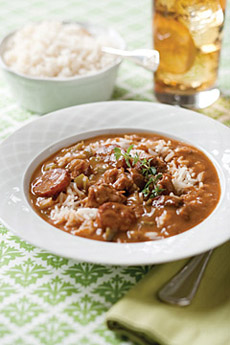
 A gumbo thickened with rice . Photo courtesy MackenzieLtd.com. A gumbo thickened with rice . Photo courtesy MackenzieLtd.com.
|
JOHNNY GNALL is a chef and freelance writer based in San Francisco.
|
|
February 2012 |
 |
Types Of Soup Thickeners
Page 3: Rice, Arrowroot & More
This is Page 3 of three-page article on soup thickeners. Click on the black links below to visit other pages.
Rice
Very common in gumbo recipes, rice can be added to a soup, stew or sauce to thicken.
If you’ve ever overcooked rice without burning it, you probably saw it turn to mush. That mush is the starch of the rice breaking down, and it is a great way to give body to the right dish.
You are welcome to cook the rice completely in the soup, sauce or stew; but you can also use already cooked rice—a great way to get rid of leftovers.
- Simply add the rice to your liquid and simmer.
- The starch will incorporate into the broth or base. The more you cook it down, stirring regularly, the thicker your dish will get.
- If rice makes sense in what you’re serving, you can cook it down any portion of the way, until you reach your desired thickness. If it’s better for the rice to go unnoticed in the recipe, simply cook it way down until it dissolves completely. This can take a while, so don’t forget to keep an eye on the pot, stirring to prevent burning, adding a bit more liquid as necessary.
Nuts & More
We’ve reviewed the most popular methods of thickening, but here are more:
- Arrowroot and Tapioca. Arrowroot and tapioca are starches that are used thicken gravies, pie fillings, puddings and sauces. They thicken without adding fat or noticeable flavor. Both also produce a high gloss. (Cornstarch, the third main starch thickener, does not yield a gloss.)
- Nuts. You can also use ground nuts as a thickener. They add a lot of richness and flavor—and also calories.
- Vegetables. You can even pull some vegetables out of your dish, purée them and reincorporate them into your liquid.
And don’t forget the Italian principle of time; it will have at least a small effect on the consistency of a dish as water evaporates and concentrates the other ingredients.
At the end of the day, you should experiment with these methods to find which you like best for which kind of cooking. To this day, my mom still ignores procedure and technique and whisks flour directly into the stock when she’s making a gravy; it still comes out thick and velvety.
Go To The Article Index Above

|




 A gumbo thickened with rice . Photo courtesy MackenzieLtd.com.
A gumbo thickened with rice . Photo courtesy MackenzieLtd.com.